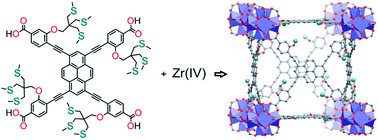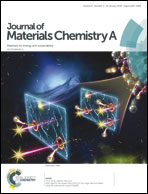Improving stability against desolvation and mercury removal performance of Zr(iv)–carboxylate frameworks by using bulky sulfur functions†
Abstract
Like killing two birds with one stone, we here utilize sulfur functionalization to simultaneously mitigate the persistent instability issue of the famous Zr(IV)-based metal–organic frameworks (MOFs) and impart effective metal uptake capabilities for broader potential applications. Thioether side groups can be conveniently designed to have various sizes and configurations, and offer unique advantages for functionalizing and stabilizing highly porous frameworks. Sulfuration as such on Zr(IV)-based frameworks is meaningful, because these MOF materials, in spite of their improved stability when protected by solvents, often degrade fast upon exposure to air, therefore limiting applications that involve gas–solid interfaces. For better practical impact, here we install sulfur side chains, e.g., tris(methylthiomethyl)methyl, that are conveniently derived from inexpensive pentaerythrityl compounds. One notable advance achieved pertains to a UiO-68-type porous solid (i.e., based on terphenyl dicarboxyl linkers) featuring long-term stability in direct exposure to air, while maintaining significant mercury uptake capability from water and organic solutions. Also discovered is a cubic NU-1100-type net that offers more efficient mercury removal capability (with regards to the adsorption capacity as well as binding strength as measured from the distribution coefficient Kd) than other thioether-equipped MOF materials.



 Please wait while we load your content...
Please wait while we load your content...